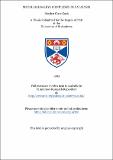Files in this item
Metal haloalkyl in complexes in catalysis
Item metadata
| dc.contributor.advisor | Cole-Hamilton, D. J. (David John) | |
| dc.contributor.author | Gash, Rosslyn Clare | |
| dc.coverage.spatial | 251 p. | en_US |
| dc.date.accessioned | 2018-06-28T11:49:48Z | |
| dc.date.available | 2018-06-28T11:49:48Z | |
| dc.date.issued | 1993 | |
| dc.identifier.uri | https://hdl.handle.net/10023/14706 | |
| dc.description.abstract | In this thesis, the preparation of a number of halomethyl complexes of rhodium, platinum, and palladium is described. Complexes of the type trans-[Rh(CH₂X)X(P₄)]+ (X = Cl, Br, I, P = PMe₃, dmpe) were found to be unstable, decomposing in situ to give a mixtures of dihalo, trihalo, and phosphine ylide species. Platinum and palladium species of the type trans-M(CH₂X)X(PEt₃)₂ (X = Cl, I, M = Pt, Pd), which were formed by the reaction between M(PEt₃)₃ CH₂XY were also unstable. In the case of platinum, phosphine ylide species were isolated from reaction mixtures, whilst the palladium halomethyl species decomposed over a number of days to give dihalide complexes. However, palladium iodomethyl species prepared via reactions involving 2 moles of phosphine per mole of metal were found to be stable. Neutral rhodium halomethyl complexes were also found to be far more stable than their cationic counterparts. The synthesis and characterisation of trans-RhCl(CO)(CH₂l)I(P)₂/ (P = PMe₃, PEt₃, or Et₂PPh), prepared by oxidative addition of CH₂I₂ to RhCl(CO)(P)₂ is described. When less basic phosphines (such as PPh₃) or the sterically hindered phosphine PCy₃ were used, no evidence of any reaction between the rhodium complex and the CH₂I₂ was observed. The molecular structure of trans-RhCl(CO)(CH₂l)I(PEt₃)₂ has been studied by X-ray diffraction analysis. This complex proved to be inert to substitution at the iodomethyl carbon atom by neutral nucleophiles such as H₂O, CH₃OH, and PEts, but prone to substitution by Cl-. The lability of iodomethyl (and chloromethyl) ligands towards CO insertion has also been studied. There is evidence to suggest that an iodoacyl platinum complex may form in solution after the complex cis-Pt(CH₂l)I(PPh₃)₂ had been left under 1 atm CO for 24 hours. However, in the case of trans-Pd(CH₂l)I(PCy₃)₂ this same reaction took 7 days under 70 atm pressure of CO. All of the rhodium iodomethyl complexes prepared were also inert to CO insertion at ambient temperature and 1 atm CO, but excellent evidence for CO insertion having taken place in irflns-RhCl(CO)(CH₂l)I(PEt₃)₂ was observed at 70°C and 35 atm of CO. Evidence for CO insertion into a rhodium-chloromethyl bond was also observed under the more forcing conditions of 100°C and 70 atm CO. This insertion reaction may prove to be extremely useful in catalytic systems. A report of some preliminary catalytic studies involving the production of diethylmalonate from CH₂I₂ and C₂-products from the hydroformylation of (CH₂O)[sub]n under very mild conditions is also presented. It is thought that these catalytic reactions proceed via carbonyl insertion into a rhodium-iodomethyl bond. | en_US |
| dc.language.iso | en | en_US |
| dc.publisher | University of St Andrews | |
| dc.subject.lcc | QD172.P8G2 | |
| dc.subject.lcsh | Platinum group | en |
| dc.title | Metal haloalkyl in complexes in catalysis | en_US |
| dc.type | Thesis | en_US |
| dc.contributor.sponsor | Science and Engineering Research Council (SERC) | en_US |
| dc.contributor.sponsor | BP Chemicals International Limited | en_US |
| dc.type.qualificationlevel | Doctoral | en_US |
| dc.type.qualificationname | PhD Doctor of Philosophy | en_US |
| dc.publisher.institution | The University of St Andrews | en_US |
This item appears in the following Collection(s)
Items in the St Andrews Research Repository are protected by copyright, with all rights reserved, unless otherwise indicated.

